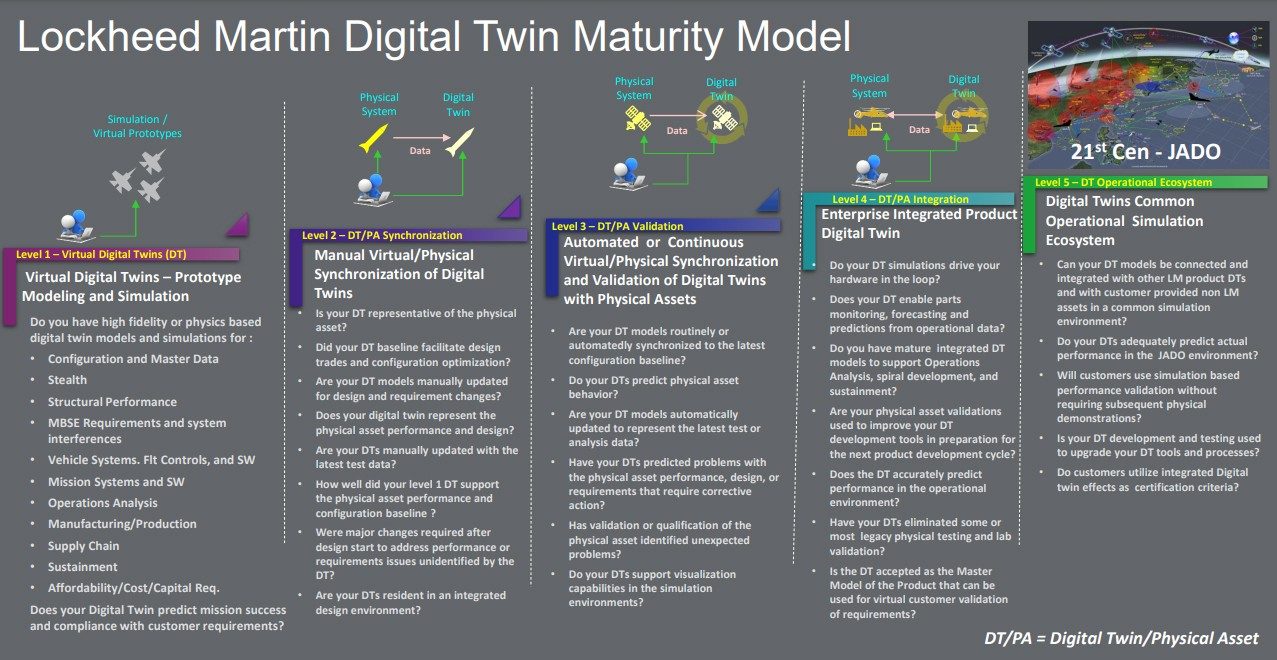The missions that our customers perform are complex. At Lockheed Martin, we are always applying new ways to deliver on these missions faster than ever before – and providing even more value. With the continued evolution of advanced technologies and the use of data to make predictions about complex systems, we are in a unique position to capitalize on the information across the digital thread of our diverse portfolio. That is where digital twins come in.
“It’s not a new idea,” says U.S. Air Force Chief Scientist Richard Joseph. “To construct a model of a physical system and run a simulation that emulates how it actually works. What’s changed is the ballooning amount of data available about the physical systems and, more importantly, the vastly increased computing power available to run digital simulations.”
Taking full advantage of these digital transformation capabilities and treating data as a strategic asset, the team is driving standardization of the complex technology of digital twins to not only promote understanding across the entire product lifecycle, but also enable interoperability across the entire industry.
“…We are in a unique position because of the global, data-driven nature of our mission to harness data and analytics across the enterprise and serve as a change agent for the entire Department of Defense.”
Defining “twinning”
Present demands of the customer missions have never been greater, and the foundational concept for customers and suppliers alike is the ability to pass data across every stage to promote transparency and aid in decision making. We have embraced digital engineering, agile development, and open systems architectures to accelerate progress together and digital twins are a critical construct for tying all the information together.
With that in mind, a common definition is key. Digital twins are “virtual representations of as-built physical assets, processes, and systems that can be used across the product life cycle using real-time data and other sources to provide actional insights.” What this really means is that twins are a “living” single source of truth driven by real data – not just a model or simulation. And, the added value of a system driven by real data is that the twins continuously inform each other for the life of the system. This means that they have the potential to drive the understanding of complex systems. They can aid in evaluating design tradeoffs before ever getting to the manufacturing stage or, for programs that are already fielded, can provide predictive decision-making for key mission operation decisions.
This overview video helps illustrate the multi-domain integration of digital twins in both production and mission operations.
Designing the playbook for a complete digital thread
So, why is this important? When using the full digital thread and data available, it means that the integration and application of digital twin technology has the potential to have a material impact on cost and schedule – and provide data-driven insights directly to the customer. By opening visibility to a full data ecosystem, we are driving access to information in an open, standard-driven environment for cross-service and cross-platform collaboration. But first, the industry needs to have a shared consensus on how that connection works.
Lockheed Martin was eager to lean into that challenge.
A lean-but-mighty team worked closely to ideate and create an initial “Digital Twin Maturity Model”– defining an appropriate stepping-stone approach to promote understanding of this complex technology and help solve some of the barriers around use cases and applications on both legacy and new programs.
“This maturity model is one step to help have discussions with our peers across the entire industry to ensure we are aligning the capabilities, technologies and investments to promote true interoperability for our warfighters,” said Johnathon Caldwell, vice president of Business Innovation, Transformation and Enterprise Excellence at Lockheed Martin Space.
With a common maturity model to promote standardization, this will help engagement across the entire supply chain. We cannot go it alone. As our customers continue to drive expectations for digital engineering and interoperability across all platforms in support of Joint All Domain Operations (JADO), this shared approach for digital twins can help shape the future of Aerospace and Defense programs.
Check out the Lockheed Martin Digital Twin Maturity Model

Eager for more?
Digital twins continually capture peoples’ attention across a variety of industries and represent a key tool for optimizing design, manufacturing, and sustainment of complex systems. Want to learn more about these capabilities, check out these resources:




